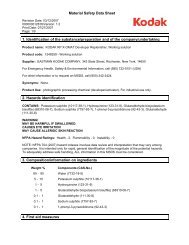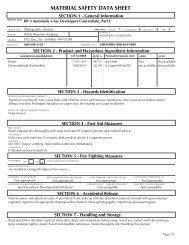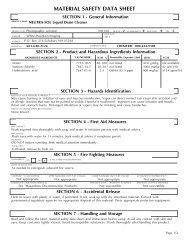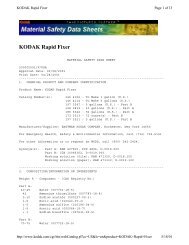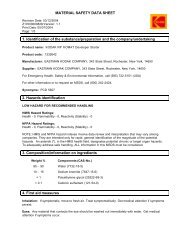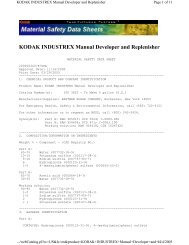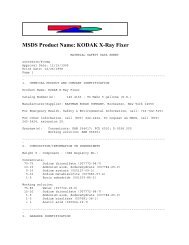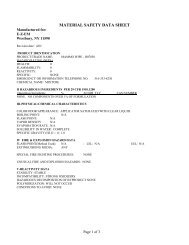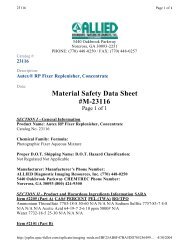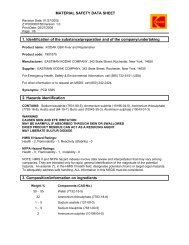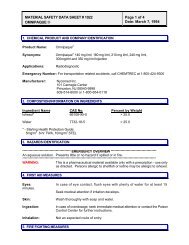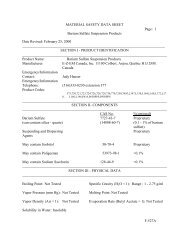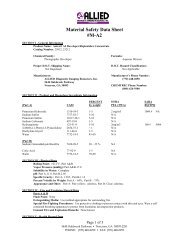MSDS Kodak GBX Developer and Replenisher
MSDS Kodak GBX Developer and Replenisher
MSDS Kodak GBX Developer and Replenisher
You also want an ePaper? Increase the reach of your titles
YUMPU automatically turns print PDFs into web optimized ePapers that Google loves.
200000317/F/USA<br />
Approval Date: 02/05/2003<br />
Print Date: 05/27/2005<br />
Page: 1/8<br />
MATERIAL SAFETY DATA SHEET<br />
------------------------------------------------------------------------------<br />
1. CHEMICAL PRODUCT AND COMPANY IDENTIFICATION<br />
Product Name: KODAK <strong>GBX</strong> <strong>Developer</strong> <strong>and</strong> <strong>Replenisher</strong><br />
Catalog Number(s):<br />
190 0943 - To Make 1 gallon (U.S.)<br />
190 1859 - Kit(s), To Make 1 gallon (U.S.)<br />
803 4001 - To Make 1 gallon (JAPAN)<br />
Manufacturer/Supplier: EASTMAN KODAK COMPANY, Rochester, New York 14650<br />
For Emergency Health, Safety & Environmental Information, call (585) 722-5151<br />
For other information or to request an <strong>MSDS</strong>, call (800) 242-2424.<br />
Synonym(s):<br />
Concentrate: KAN 427847; PCD 4861; C-0070.050<br />
Working solution: KAN 966184<br />
------------------------------------------------------------------------------<br />
2. COMPOSITION/INFORMATION ON INGREDIENTS<br />
Weight % - Component - (CAS Registry No.)<br />
Concentrate:<br />
60-65 Water (007732-18-5)<br />
5-10 Potassium sulfite (010117-38-1)<br />
5-10 Diethylene glycol (000111-46-6)<br />
5-10 Sodium sulfite (007757-83-7)<br />
6 Hydroquinone (000123-31-9)<br />
1-5 Potassium carbonate (000584-08-7)<br />
< 1 4-hydroxymethyl-4-methyl-1-phenyl-3-pyrazolidinone (013047-13-7)<br />
Working solution:<br />
90-95 Water (007732-18-5)<br />
1-5 Potassium sulfite (010117-38-1)<br />
1-5 Diethylene glycol (000111-46-6)<br />
1-5 Sodium sulfite (007757-83-7)<br />
1-5 Hydroquinone (000123-31-9)<br />
------------------------------------------------------------------------------<br />
3. HAZARDS IDENTIFICATION<br />
Concentrate:<br />
CONTAINS: Hydroquinone (000123-31-9); Diethylene glycol (000111-46-6);<br />
Potassium sulfite (010117-38-1); Sodium sulfite (007757-83-7);<br />
4-hydroxymethyl-4-methyl-1-phenyl-3-pyrazolidinone (013047-13-7)<br />
WARNING!<br />
HARMFUL IF SWALLOWED<br />
CAUSES EYE IRRITATION<br />
CAN CAUSE KIDNEY DAMAGE AND CNS EFFECTS FOLLOWING INGESTION<br />
HMIS Hazard Ratings:<br />
Health - * 2, Flammability - 1, Reactivity - 0, Personal Protection - B<br />
NFPA Hazard Ratings:<br />
Health - 2, Flammability - 1, Reactivity (Stability) - 0
MATERIAL SAFETY DATA SHEET<br />
200000317/F/USA<br />
Approval Date: 02/05/2003<br />
Print Date: 05/27/2005<br />
Page: 2/8<br />
------------------------------------------------------------------------------<br />
Working solution:<br />
CONTAINS: Hydroquinone (000123-31-9); Diethylene glycol (000111-46-6);<br />
Potassium sulfite (010117-38-1); Sodium sulfite (007757-83-7)<br />
WARNING!<br />
HARMFUL IF SWALLOWED<br />
CAUSES EYE IRRITATION<br />
CAN CAUSE KIDNEY DAMAGE AND CNS EFFECTS FOLLOWING INGESTION<br />
HMIS Hazard Ratings:<br />
Health - * 2, Flammability - 0, Reactivity - 0, Personal Protection - B<br />
NFPA Hazard Ratings:<br />
Health - 1, Flammability - 0, Reactivity (Stability) - 0<br />
NOTE: HMIS <strong>and</strong> NFPA hazard indexes involve data review <strong>and</strong> interpretation that<br />
may vary among companies. They are intended only for rapid, general<br />
identification of the magnitude of the potential hazards. The personal<br />
protection index is only intended for general guidance on personal protection<br />
equipment (PPE) that is suitable for the potential hazards of the material.<br />
PPE (e.g., respirators) may not be needed if engineering controls (e.g., local<br />
ventilation) are adequate. An asterisk (*), in the HMIS health field,<br />
designates potential chronic or target organ hazards. To adequately address<br />
safe h<strong>and</strong>ling, ALL information in this <strong>MSDS</strong> must be considered.<br />
------------------------------------------------------------------------------<br />
4. FIRST-AID MEASURES<br />
Inhalation: If symptomatic, move to fresh air. Treat symptomatically. Get<br />
medical attention if symptoms persist.<br />
Eyes: Immediately flush with plenty of water for at least 15 minutes. Get<br />
medical attention.<br />
Skin: Get medical attention if symptoms occur. Wash contaminated clothing<br />
before reuse. Destroy or thoroughly clean contaminated shoes.<br />
Ingestion: Only induce vomiting at the instruction of medical personnel. Never<br />
give anything by mouth to an unconscious person. Call a physician or poison<br />
control center immediately.<br />
------------------------------------------------------------------------------<br />
5. FIRE FIGHTING MEASURES<br />
Extinguishing Media:<br />
Concentrate: Water spray, carbon dioxide (CO2), dry chemical, alcohol foam<br />
Working solution: Use appropriate agent for adjacent fire.<br />
Special Fire-Fighting Procedures: Wear self-contained breathing apparatus <strong>and</strong><br />
protective clothing. Fire or excessive heat may produce hazardous<br />
decomposition products.<br />
Hazardous Combustion Products:<br />
Concentrate: Carbon dioxide, carbon monoxide, oxides of sulfur (see also<br />
Hazardous Decomposition Products section)
MATERIAL SAFETY DATA SHEET<br />
200000317/F/USA<br />
Approval Date: 02/05/2003<br />
Print Date: 05/27/2005<br />
Page: 3/8<br />
------------------------------------------------------------------------------<br />
Working solution: None (noncombustible) (see also Hazardous Decomposition<br />
Products section)<br />
Unusual Fire <strong>and</strong> Explosion Hazards: None<br />
------------------------------------------------------------------------------<br />
6. ACCIDENTAL RELEASE MEASURES<br />
Flush to sewer with large amounts of water. Otherwise, absorb spill with<br />
vermiculite or other inert material, then place in a container for chemical<br />
waste. Clean surface thoroughly to remove residual contamination.<br />
------------------------------------------------------------------------------<br />
7. HANDLING AND STORAGE<br />
Personal Precautionary Measures: Avoid prolonged or repeated breathing of<br />
vapor. Avoid contact with eyes, skin, <strong>and</strong> clothing. Use with adequate<br />
ventilation. Wash thoroughly after h<strong>and</strong>ling.<br />
Prevention of Fire <strong>and</strong> Explosion:<br />
Concentrate: Keep from contact with oxidizing materials.<br />
Working solution: No special precautionary measures should be needed under<br />
anticipated conditions of use.<br />
Storage: Keep container tightly closed. Keep away from incompatible substances<br />
(see Incompatibility section).<br />
------------------------------------------------------------------------------<br />
8. EXPOSURE CONTROLS/PERSONAL PROTECTION<br />
Exposure Limits:<br />
ACGIH Threshold Limit Value (TLV):<br />
Hydroquinone: 2 mg/m3 TWA<br />
Eastman <strong>Kodak</strong> Company industrial hygiene guideline:<br />
4-hydroxymethyl-4-methyl-1-phenyl-3-pyrazolidinone: 0.2 mg/m3 TWA<br />
OSHA (USA) Permissible Exposure Limit (PEL - 1971 Table Z-1 Values):<br />
Hydroquinone: 2 mg/m3 TWA<br />
AIHA Workplace Environmental Exposure Level (WEEL):<br />
Diethylene glycol: 10 mg/m3, 8 hr TWA (aerosol)<br />
Ventilation: Good general ventilation (typically 10 air changes per hour)<br />
should be used. Ventilation rates should be matched to conditions.<br />
Respiratory Protection: None should be needed. A respirator should be worn if<br />
hazardous decomposition products are likely to be or have been released.<br />
Respirator type: Acid gas. See Stability <strong>and</strong> Reactivity Section. If<br />
respirators are used, a program should be instituted to assure compliance with<br />
OSHA St<strong>and</strong>ard 29 CFR 1910.134.
MATERIAL SAFETY DATA SHEET<br />
200000317/F/USA<br />
Approval Date: 02/05/2003<br />
Print Date: 05/27/2005<br />
Page: 4/8<br />
------------------------------------------------------------------------------<br />
Eye Protection: Wear safety glasses with side shields (or goggles).<br />
Skin Protection: It is a good industrial hygiene practice to minimize skin<br />
contact. Wear impervious gloves <strong>and</strong> protective clothing appropriate for the<br />
risk of exposure.<br />
Recommended Decontamination Facilities: Eye bath, washing facilities, safety<br />
shower<br />
------------------------------------------------------------------------------<br />
9. PHYSICAL AND CHEMICAL PROPERTIES<br />
Physical Form: Liquid<br />
Color:<br />
Concentrate: Slight yellow<br />
Working solution: Colorless<br />
Odor: Odorless<br />
Specific Gravity (water = 1):<br />
Concentrate: 1.230<br />
Working solution: 1.0283<br />
Vapor Pressure at 20°C (68°F): 24 mbar (18 mm Hg)<br />
Vapor Density (Air = 1): 0.6<br />
Volatile Fraction by Weight:<br />
Concentrate: 65 %<br />
Working solution: 90 %<br />
Boiling Point: >100°C (>212°F)<br />
Solubility in Water: Complete<br />
pH:<br />
Concentrate: 10.2<br />
Working solution: 9.85-10.05<br />
Flash Point:<br />
Concentrate: None<br />
Working solution: None, noncombustible liquid<br />
------------------------------------------------------------------------------<br />
10. STABILITY AND REACTIVITY<br />
Stability: Stable<br />
Incompatibility:<br />
Concentrate: Strong oxidizing agents, strong acids<br />
Working solution: Strong acids<br />
Hazardous Decomposition Products: Sulfur dioxide<br />
Hazardous Polymerization: Will not occur.<br />
------------------------------------------------------------------------------<br />
11. TOXICOLOGICAL INFORMATION<br />
Effects of Exposure:<br />
General:<br />
Contains diethylene glycol. Can cause kidney damage <strong>and</strong> CNS effects<br />
following ingestion.
MATERIAL SAFETY DATA SHEET<br />
200000317/F/USA<br />
Approval Date: 02/05/2003<br />
Print Date: 05/27/2005<br />
Page: 5/8<br />
------------------------------------------------------------------------------<br />
Contains hydroquinone. This mixture contains hydroquinone which is<br />
classified as a dermal sensitizer in some jurisdictions. A very similar<br />
mixture was negative in dermal sensitization studies with <strong>and</strong> without<br />
prior sensitization to hydroquinone. Based on the results of these<br />
studies, this mixture is not expected to present a dermal sensitization<br />
hazard to humans. Carcinogenicity studies in animals were inconclusive.<br />
Rats <strong>and</strong> mice were given hydroquinone by stomach tube or at high<br />
concentrations in the diet. Responses were not consistent across route of<br />
exposure, species or sex. The International Agency for Research on Cancer<br />
(IARC) has classified hydroquinone in Group 3, i.e.,"not classifiable" as<br />
a carcinogen. Hydroquinone is generally negative in bacterial mutagenicity<br />
tests; there is evidence for the clastogenicity (chromosome breakage) of<br />
hydoquinone in vivo <strong>and</strong> in vitro. The relevance of chromosomal effects in<br />
test animals in predicting human risk is unclear. No increases in cancer<br />
rates were observed in an epidemiology study which looked at mortality<br />
among more than 800 persons employed primarily in the manufacture of<br />
hydroquinone. There is insufficient evidence for classifying hydroquinone<br />
as a suspected carcinogenic or mutagenic substance in humans.<br />
Inhalation: Expected to be a low hazard for recommended h<strong>and</strong>ling. In contact<br />
with strong acids or if heated, sulfites may liberate sulfur dioxide gas.<br />
Sulfur dioxide gas is irritating to the respiratory tract. Some asthmatics<br />
or hypersensitive individuals may experience difficult breathing.<br />
Eyes: Causes irritation.<br />
Skin: Prolonged or repeated contact with aqueous solutions may cause<br />
irritation. May cause skin depigmentation.<br />
Ingestion: Harmful if swallowed. Can cause kidney damage <strong>and</strong> CNS effects<br />
following ingestion. Some asthmatics or sulfite-sensitive individuals may<br />
experience wheezing, chest tightness, stomach upset, hives, faintness,<br />
weakness <strong>and</strong> diarrhea.<br />
Acute Toxicity Data:<br />
Data for a very similar material. CIN 10095088; PCD 6400<br />
Oral LD-50: >2000 mg/kg<br />
Skin sensitization: negative<br />
------------------------------------------------------------------------------<br />
12. ECOLOGICAL INFORMATION<br />
The following properties are ESTIMATED from the components of the<br />
preparations. The effects of hydroquinone are considered the most significant<br />
in this estimation:<br />
Concentrate<br />
Working Solution<br />
Potential Toxicity<br />
Fish LC50 mg/l: 1-10 1-10<br />
Daphnid EC50 mg/l: 70%):
MATERIAL SAFETY DATA SHEET<br />
200000317/F/USA<br />
Approval Date: 02/05/2003<br />
Print Date: 05/27/2005<br />
Page: 6/8<br />
------------------------------------------------------------------------------<br />
Potential Log Pow 100<br />
microorganisms EC50<br />
(mg/l):<br />
------------------------------------------------------------------------------<br />
13. DISPOSAL CONSIDERATIONS<br />
Discharge, treatment, or disposal may be subject to national, state, or local<br />
laws.<br />
Since emptied containers retain product residue, follow label warnings even<br />
after container is emptied.<br />
------------------------------------------------------------------------------<br />
14. TRANSPORT INFORMATION<br />
For transportation information regarding this product call the <strong>Kodak</strong> Worldwide<br />
Transportation Hazmat Hot Line: (585) 722-2400 between 8 a.m. <strong>and</strong> 5 p.m.<br />
(Eastern St<strong>and</strong>ard Time), Monday through Friday.<br />
------------------------------------------------------------------------------<br />
15. REGULATORY INFORMATION<br />
Material(s) known to the State of California to cause cancer: None<br />
Material(s) known to the State of California to cause adverse reproductive<br />
effects: None<br />
Carcinogenicity Classification (components present at 0.1% or more):<br />
International Agency for Research on Cancer (IARC): Hydroquinone: Group 3 -<br />
not classifiable. Sulfur dioxide, some sulfites, bisulfites <strong>and</strong><br />
metasulfites: Group 3 - not classifiable.<br />
American Conference of Governmental Industrial Hygienists (ACGIH):<br />
Hydroquinone, A3; Confirmed animal carcinogen with unknown relevance to<br />
humans.<br />
National Toxicology Program (NTP): None<br />
Occupational Safety <strong>and</strong> Health Administration (OSHA): None<br />
Chemical(s) subject to the reporting requirements of Section 313 or Title III<br />
of the Superfund Amendments <strong>and</strong> Reauthorization Act (SARA) of 1986 <strong>and</strong> 40 CFR<br />
Part 372: Hydroquinone<br />
------------------------------------------------------------------------------<br />
16. OTHER INFORMATION<br />
US/Canadian Label Statements:<br />
Concentrate:<br />
CONTAINS: Hydroquinone (000123-31-9); Diethylene glycol (000111-46-6);<br />
Potassium sulfite (010117-38-1); Sodium sulfite (007757-83-7);<br />
4-hydroxymethyl-4-methyl-1-phenyl-3-pyrazolidinone (013047-13-7)<br />
WARNING!
MATERIAL SAFETY DATA SHEET<br />
200000317/F/USA<br />
Approval Date: 02/05/2003<br />
Print Date: 05/27/2005<br />
Page: 7/8<br />
------------------------------------------------------------------------------<br />
HARMFUL IF SWALLOWED<br />
CAUSES EYE IRRITATION<br />
CAN CAUSE KIDNEY DAMAGE AND CNS EFFECTS FOLLOWING INGESTION<br />
Avoid prolonged or repeated breathing of vapor.<br />
Avoid contact with eyes, skin, <strong>and</strong> clothing.<br />
Use with adequate ventilation.<br />
Wash thoroughly after h<strong>and</strong>ling.<br />
FIRST AID: If swallowed, only induce vomiting as directed by medical<br />
personnel. Never give anything by mouth to an unconscious person. Call a<br />
physician or poison control center immediately. In case of eye contact,<br />
immediately flush eyes with plenty of water for at least 15 minutes. Get<br />
medical attention if symptoms occur.<br />
Keep out of reach of children.<br />
For additional information, see Material Safety Data Sheet (<strong>MSDS</strong>) for this<br />
material.<br />
Additional hazard precautions for containers greater than 1 gallon of<br />
liquid or 5 pounds of solid:<br />
Since emptied containers retain product residue, follow label warnings<br />
even after container is emptied.<br />
IN CASE OF FIRE: Use water spray, carbon dioxide (CO2), dry chemical,<br />
alcohol foam<br />
IN CASE OF SPILL: Absorb spill with inert material, then place in a<br />
chemical waste container. Flush residual spill or area with water. For<br />
large spills, dike for later disposal. Prevent runoff from entering<br />
drains, sewers, <strong>and</strong> streams.<br />
Working solution:<br />
CONTAINS: Hydroquinone (000123-31-9); Diethylene glycol (000111-46-6);<br />
Potassium sulfite (010117-38-1); Sodium sulfite (007757-83-7)<br />
WARNING!<br />
HARMFUL IF SWALLOWED<br />
CAUSES EYE IRRITATION<br />
CAN CAUSE KIDNEY DAMAGE AND CNS EFFECTS FOLLOWING INGESTION<br />
Avoid prolonged or repeated breathing of vapor.<br />
Avoid contact with eyes, skin, <strong>and</strong> clothing.<br />
Use with adequate ventilation.<br />
Wash thoroughly after h<strong>and</strong>ling.<br />
FIRST AID: If swallowed, only induce vomiting as directed by medical<br />
personnel. Never give anything by mouth to an unconscious person. Call a<br />
physician or poison control center immediately. In case of eye contact,<br />
immediately flush eyes with plenty of water for at least 15 minutes. Get<br />
medical attention if symptoms occur.<br />
Keep out of reach of children.<br />
For additional information, see Material Safety Data Sheet (<strong>MSDS</strong>) for this<br />
material.
MATERIAL SAFETY DATA SHEET<br />
200000317/F/USA<br />
Approval Date: 02/05/2003<br />
Print Date: 05/27/2005<br />
Page: 8/8<br />
------------------------------------------------------------------------------<br />
Additional hazard precautions for containers greater than 1 gallon of<br />
liquid or 5 pounds of solid:<br />
Since emptied containers retain product residue, follow label warnings<br />
even after container is emptied.<br />
------------------------------------------------------------------------------<br />
The information contained herein is furnished without warranty of any kind.<br />
Users should consider these data only as a supplement to other information<br />
gathered by them <strong>and</strong> must make independent determinations of suitability <strong>and</strong><br />
completeness of information from all sources to assure proper use <strong>and</strong> disposal<br />
of these materials <strong>and</strong> the safety <strong>and</strong> health of employees <strong>and</strong> customers <strong>and</strong><br />
the protection of the environment.<br />
------------------------------------------------------------------------------<br />
Concentrate:R-1, S-2, F-1, C-0<br />
WS:R-1, S-2, F-0, C-0




